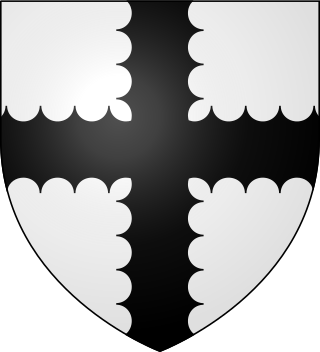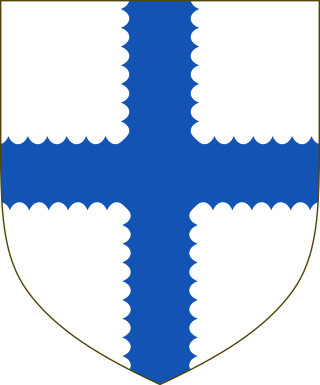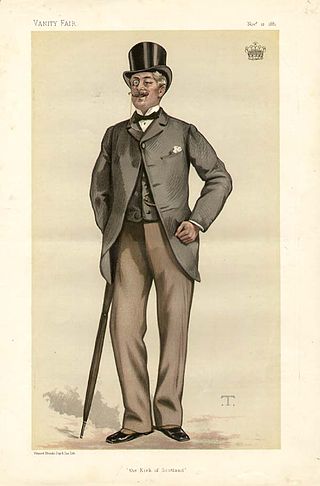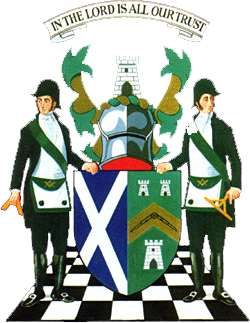The history of Freemasonry encompasses the origins, evolution and defining events of the fraternal organisation known as Freemasonry. It covers three phases. Firstly, the emergence of organised lodges of operative masons during the Middle Ages, then the admission of lay members as "accepted" or "speculative" masons, and finally the evolution of purely speculative lodges, and the emergence of Grand Lodges to govern them. The watershed in this process is generally taken to be the formation of the first Grand Lodge in London in 1717. The two difficulties facing historians are the paucity of written material, even down to the 19th century, and the misinformation generated by masons and non-masons alike from the earliest years.

Henry I Sinclair, Earl of Orkney, Lord of Roslin was a Scottish nobleman. Sinclair held the title Earl of Orkney and was Lord High Admiral of Scotland under the King of Scotland. He was sometimes identified by another spelling of his surname, St. Clair. He was the grandfather of William Sinclair, 1st Earl of Caithness, the builder of Rosslyn Chapel. He is best known today because of a modern legend that he took part in explorations of Greenland and North America almost 100 years before Christopher Columbus. William Thomson, in his book The New History of Orkney, wrote: "It has been Earl Henry's singular fate to enjoy an ever-expanding posthumous reputation which has very little to do with anything he achieved in his lifetime."

Rosslyn Chapel, formerly known as the Collegiate Chapel of Saint Matthew, is a 15th-century Episcopal chapel located in the village of Roslin in Midlothian, Scotland. The chapel was founded by William Sinclair, 1st Earl of Caithness with a ground-breaking ceremony in 1456. After the Scottish Reformation in 1560, it was largely abandoned but, following a visit by Queen Victoria, it was rededicated in 1862. It was the target of a bombing in 1914 during the suffragette bombing and arson campaign. The interior contains some fine carvings which many historians have sought to interpret.

Lord Sinclair is a title in the Peerage of Scotland. According to James Balfour Paul's The Scots Peerage, volume VII published in 1910, the first person to be styled Lord Sinclair was William Sinclair, 3rd Earl of Orkney and 1st Earl of Caithness. However, according to Roland Saint-Clair writing in the late 19th century, William Sinclair's father, Henry II Sinclair, Earl of Orkney, who died in 1420, is the first person recorded as Lord Sinclair by public records.

Robert Francis St Clair-Erskine, 4th Earl of Rosslyn, styled Lord Loughborough from 1851 until 1866, was a British Conservative politician. He served as Captain of the Gentlemen-at-Arms under Lord Salisbury between 1886 and 1890.

George Douglas, 16th Earl of Morton, KT, FRS, FRSE, FSA was a Scottish peer and politician.

The Grand Lodge of Antient Free and Accepted Masons of Scotland is the governing body of Freemasonry in Scotland. It was founded in 1736. About one third of Scotland's lodges were represented at the foundation meeting of the Grand Lodge.

Clan Sinclair is a Highland Scottish clan which holds the lands of Caithness, the Orkney Islands, and the Lothians. The chiefs of the clan were the Barons of Roslin and later the Earls of Orkney and Earls of Caithness.

The Knights Templar, full name The United Religious, Military and Masonic Orders of the Temple and of St John of Jerusalem, Israel, Rhodes and Malta, is a fraternal order affiliated with Freemasonry. Unlike the initial degrees conferred in a regular Masonic Lodge, which only require a belief in a Supreme Being regardless of religious affiliation, the Knights Templar is one of several additional Masonic Orders in which membership is open only to Freemasons who profess a belief in Christianity. One of the obligations entrants to the order are required to declare is to protect and defend the Christian faith. The word "United" in its full title indicates that more than one historical tradition and more than one actual order are jointly controlled within this system. The individual orders 'united' within this system are principally the Knights of the Temple, the Knights of Malta, the Knights of St Paul, and only within the York Rite, the Knights of the Red Cross.

Lodge Mother Kilwinning is a Masonic Lodge in Kilwinning, Scotland, under the auspices of the Grand Lodge of Scotland. It is number 0 on the Roll, and is reputed by some to be the oldest Lodge not only in Scotland, but the world. There is no existing evidence to support this claim however. It is styled The Mother Lodge of Scotland attributing its origins to the 12th Century, and is often called Mother Kilwinning.

There are Masonic degrees named after the Knights Templar but not all Knights Templar Orders are Masonic.
There are a number of masonic manuscripts that are important in the study of the emergence of Freemasonry. Most numerous are the Old Charges or Constitutions. These documents outlined a "history" of masonry, tracing its origins to a biblical or classical root, followed by the regulations of the organisation, and the responsibilities of its different grades. More rare are old hand-written copies of ritual, affording a limited understanding of early masonic rites. All of those which pre-date the formation of Grand Lodges are found in Scotland and Ireland, and show such similarity that the Irish rituals are usually assumed to be of Scottish origin. The earliest Minutes of lodges formed before the first Grand Lodge are also located in Scotland. Early records of the first Grand Lodge in 1717 allow an elementary understanding of the immediate pre-Grand Lodge era and some insight into the personalities and events that shaped early-18th-century Freemasonry in Britain.

Baron of Roslin or Rosslyn was a Scottish feudal barony held by the St Clair or Sinclair family.
Freemasonry in Scotland in lodges chartered by the Grand Lodge of Scotland comprises the Scottish Masonic Constitution as regular Masonic jurisdiction for the majority of freemasons in Scotland. There are also lodges operating under the Scottish Masonic Constitution in countries outside of Scotland. Many of these are countries linked to Scotland and the United Kingdom through the Commonwealth of Nations and prior colonies and other settlements of the British Empire although there are several lodges in countries such as Lebanon, Belgium, Chile and Peru, which do not have such connections.

James Burnes was a Scottish doctor and surgeon in India, who became physician-general of Bombay.
Father Richard Augustine Hay (1661-c.1736) was prior of St. Pierremont, France, and antiquary.

William St. Clair, 6th Baron of Roslin was a Scottish nobleman of the late 13th century.

William St Clair was a Scottish nobleman and the 16th Baron of Roslin.

Lord Herdmanston was a title in the Peerage of Scotland that was held by the Sinclair or St Clair family.











